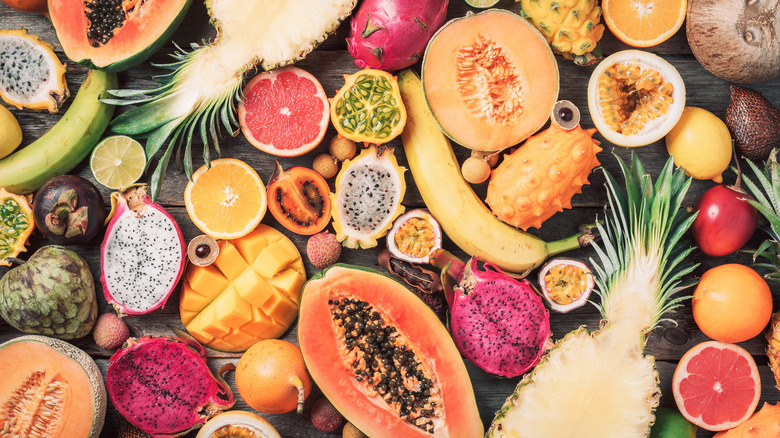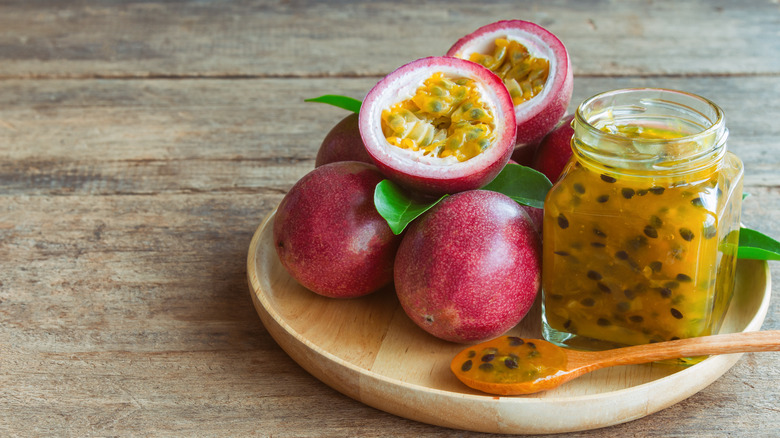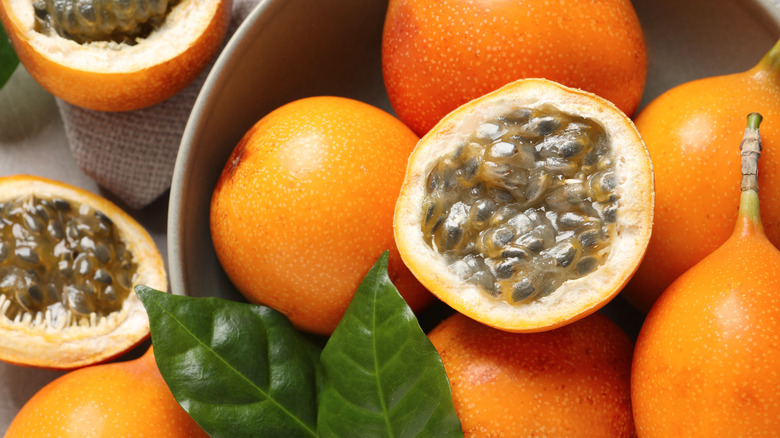Is A Granadilla The Same As A Passion Fruit?
Ah, those sassy tropical fruits perking up ordinary cocktails, smoothies, and salads with color, texture, and a blaze of little black dots — we're talking about passion fruits, in all their fruit-full glory. Bringing tropical flair to tables across the world, these beauties are native to South America, with most of them traveling from a home base of Brazil.
Fortunately, extended family members of the passion fruit family are also intrepid travelers, including the similar but distinct granadilla fruit. It answers scientifically to the family name of Passiflora ligularis and is similarly native to Central and South America. However, both fruits have acclimated to tropical and subtropical regions across the globe, including several varieties thriving in the state of Florida.
Not only does the Passifloraceae family bring brilliant hues and sweet, tangy flavor to the culinary scene, but they also harbor some health benefits as well. Science Direct notes the popularity of passion fruits and granadillas amongst folk medicine advocates, who tout them as remedies for insomnia, asthma, bronchitis, anxiety, and more. They contain valuable vitamins, minerals, and compounds such as flavonoids and phenolic acids that can act as anti-inflammatories and guard against cardiovascular disease.
But the family tree does diverge at a certain point, primarily when it comes to varying characteristics. Though subtle, they are defining. From size to color, shape, and taste, here's a look at how these fruity cousins differ, while still remaining somewhat interchangeable in recipes.
Passion for passion fruits
Those who love passion fruits really love them. And what's not to adore? They brighten a table, counter, or bar at first glance, from the rich skin colors to punchy black seeds with mellow-yellow gelatinous coatings. Depending on the particular variety, the exteriors exude tropical hues of purple, green, or yellow, which differs from the singular deeper orange shades of the granadilla.
Passions fruits have a slightly oval shape and relatively hard exterior skin, similar to the more rounded granadillas, though they're smaller and give way more easily to peeling and slicing. The little lovelies pack a wealth of flavor into their 2.5 to 3.5 inches of edible space.
From sweet to tart and even floral, passion fruit lovers hail the nuanced flavor notes infusing passion-fruit cocktails, jams, and desserts. All you have to do is scoop out the seeds and pulp, then eat it all, either fresh or folded into smoothies, cereals, yogurts, salads, baked muffins, or whatever your imagination conjures up.
Granadillas and their grandly sweet flavor
On the heels of their more widely known passion-fruit cousins come the grand granadillas. Considerably larger at 4 to 6 inches, these fruits could be mistaken for oranges at first glance. They're also often confused with the yellow passion fruit variety, but a side-by-side comparison highlights the deeper orange hue.
The rind of a granadilla remains smooth even when fully ripe, which contrasts with the purple variety of passion fruit that tends to wrinkle and dimple when mature. Because the granadilla surface skin is harder than most passion fruits, it can get brittle and crack open easily. The seeds, like those in passion fruits, tend to be crunchy and tart, but are noticeably larger.
Tropical fruit fans celebrate the extra sweetness of the granadilla while enjoying the slight tangy twist, which can help balance other flavors in fruity cocktails, cakes, parfaits, ice creams, and even kid-favorite popsicles or slushies.
Because of similar familial features, such as the seeds and sweet/tart gelatinous pulp, passion fruits and granadillas can slip in for one another in many recipes. Just take into account the slight flavor variations and the larger granadilla seeds, which could overly dominate delicate mixed drinks or custards.


